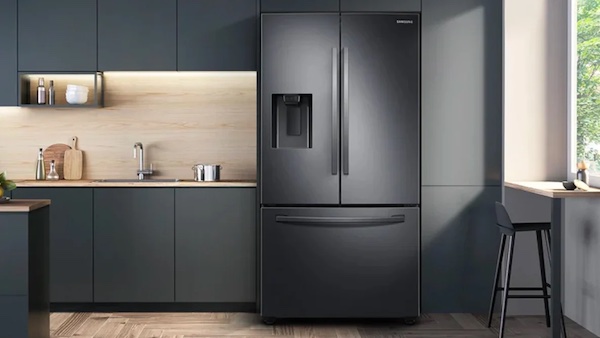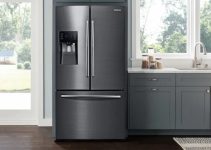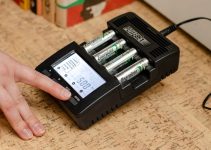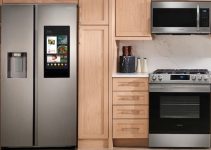It can be perplexing to discover that one component of your Samsung refrigerator works, but the other does not, like in the case where you find the refrigerator to be warm but the freezer to be chilly.
However, this is one of those typical refrigerator problems that, if you know where to look for the answer, you can find a precise solution. When the refrigerator is warm, but the freezer is cool, we will help troubleshoot the problem, which could be caused by anything from frozen evaporator coils to a malfunctioning damper control.

Why is My Samsung Refrigerator Not Cooling?
If the cooling component of your Samsung refrigerator is malfunctioning, but the freezer section is operating normally, there are many possible reasons. Here are some of them:
- Frosted Evaporator Coils.
- Damper Control Assembly
- Faulty Evaporator Fan Motor
- Faulty Thermistor
- Temperature Control Board
- Defrost Control Board
- Broken Defrost Thermostat
- Faulty Defrost Timer
- Main Control Board
1. Frosted Evaporator Coils
During the day, the defrost heater assembly will switch on a few times to defrost the evaporator coils and remove any ice that may have formed there. Frost will continue to build up on the evaporator coils and eventually cause the coils to become clogged with frost if the defrost heater assembly is faulty.
If the evaporator coils become covered in frost, the airflow through the coils will be impeded, and as a result, the refrigerator will not be able to cool the food properly. Determine whether or not the evaporator coils have developed a frosty coating by inspecting them. If the evaporator coils are covered in ice, you should check each system component that defrosts them.
2. Faulty Evaporator Fan Motor
The cold air that is drawn over the evaporator coils by the fan motor of the evaporator is then circulated throughout the freezer. If the evaporator fan in the freezer or refrigerator is not functioning properly, the appliance will not cool as it should. If you want to determine if the motor that drives the evaporator fan is broken, try turning the fan blade by hand. If the fan blades are stuck and cannot turn freely, the motor should be replaced.
In addition, the motor should be replaced if it has an abnormally high noise level. Finally, if the motor does not run, you should check the motor’s windings using a multimeter to see whether there is continuity. It is necessary to replace the evaporator fan motor if there is no continuity in the windings.
3. Damper Control Assembly
The air damper control allows cold air to enter the refrigerator compartment by opening and closing it as needed. If the damper does not apply away, the refrigerator will not receive enough cold air. Examine the control for the damper to see if it is damaged in any way.
4. Faulty Thermistor
The refrigerator’s internal temperature is tracked by the thermistor, which reports its findings to the control board. The control board monitors the temperature readings from the thermistors and adjusts the voltage to the compressor and evaporator fan accordingly.
The compressor and evaporator fan may not activate when needed or may activate too frequently if the thermistor is broken. Checking the thermistor with a multimeter will help determine whether it’s broken. In a well-functioning fridge, the thermistor’s resistance would vary as the temperature did. Replacing the thermistor is necessary if its resistance remains constant or lacks continuity.
5. Temperature Control Board
The compressor and fan motors get their power from the thermostat board. The compressor and fan motors may stop working if the control board fails to supply power. Misdiagnosis of control boards is widespread; before replacing the board, ensure all of the more prevalent problem areas are ruled out. The temperature control board should be replaced if all other parts are in good working order.
6. Defrost Control Board
The frequency with which the defrost cycle will be performed is set by the defrost control board. When the defrost control board in a refrigerator breaks, the defrost cycle will not be activated, and frost will build up again on the evaporator coils. Refrigerators will have to work harder to remove heat if the evaporator coils freeze.
The fridge can even get too hot to store perishables in. The defrost control board is likely broken if the thermostat and defrost heater are functional.
7. Broken Defrost Thermostat
The defrost thermostat continuously monitors the evaporator coil temperature. During the defrost cycle, the thermostat contacts close when the coils cool below a predetermined temperature, supplying electricity to the defrost heater. At the start of the defrost cycle, the evaporator coils are heated by the defrost heater to remove any frost that has formed.
The thermostat contacts will not close if the defrost thermostat is broken. Therefore, the defrost heater will not receive power from the thermostat. Test the defrost thermostat’s continuity using a multimeter to see whether it’s broken. Replace the defrost thermostat if it loses continuity at the cold end of its operational temperature range.
8. Faulty Defrost Timer
To prevent frost from forming on the evaporator coils, a defrost timer periodically activates a defrost heater. It’s possible that the defrost timer won’t start the defrost cycle or won’t provide power to the defrost heater if it’s faulty.
The refrigerator’s energy consumption will increase as frost builds up on the evaporator coils if the defrost system isn’t functioning properly. The fridge can even get too hot to store perishables in. Slowly moving the dial into the defrost cycle will reveal any problems with the defrost timer. When the temperature drops, the compressor should shut off, and the heater should come on.
Within 30 minutes, the defrost timer should have sent electricity to the defrost components and advanced out of the defrost cycle. The defrost timer needs to be replaced if it is not counting down.
9. Main Control Board
There is a possibility that the primary control board is faulty. On the other hand, the control board is rarely the source of the issue. Before you go and replace the control board, make sure you have tested all of the components that fail the most frequently. If none of these components have any problems, you might want to think about replacing the main control board.
Wrap-up
There may be additional causes for the situation in which the refrigerator is not cooling, but the freezer is working, but we have concentrated mainly on the most critical aspects of the problem. If you’ve checked all of the above-listed procedures and you still can’t get it fixed, do well to contact a qualified repairer to get the job done.




